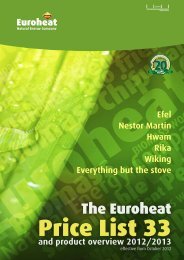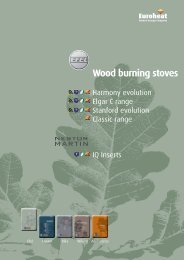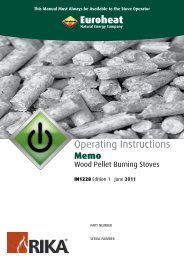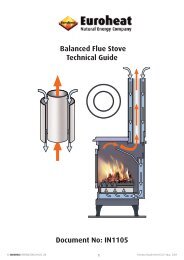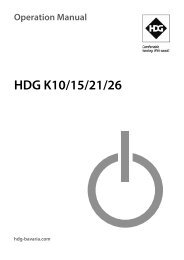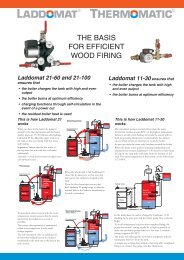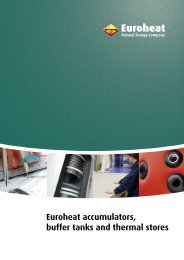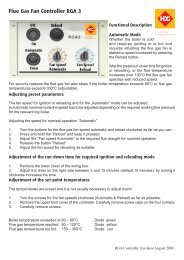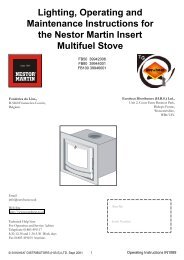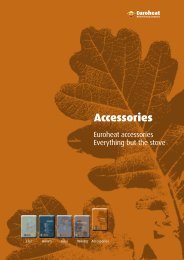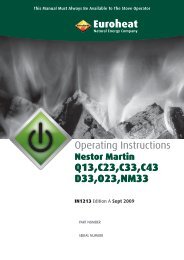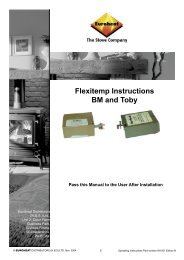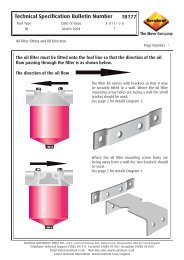Flue thermostat - Ecoangus
Flue thermostat - Ecoangus
Flue thermostat - Ecoangus
You also want an ePaper? Increase the reach of your titles
YUMPU automatically turns print PDFs into web optimized ePapers that Google loves.
Art.no.<br />
13 10 01<br />
Technical data<br />
Single <strong>thermostat</strong> 50–300°C<br />
For fi tting on outside of fl ue<br />
Change-over switch<br />
Capillary tube, length 1.5 m<br />
Installation fi ttings included<br />
Probe length 75 mm<br />
Probe diameter 5 mm<br />
Resistive load 16 A at 250 V<br />
10 A at 380 V<br />
Inductive load 5 A at 220 V<br />
1 A at 380 V<br />
Rrtermostat_E.PMD<br />
831001-E<br />
060209<br />
Laddomat ®<br />
<strong>Flue</strong> <strong>thermostat</strong><br />
Function<br />
Used to start and stop the charging pump between<br />
boiler and storage tank.<br />
The fl ue <strong>thermostat</strong> starts the pump as soon as the<br />
temperature of the smoke pipe rises to a predetermined<br />
level, after fi ring starts.<br />
In wood-fi red boilers with self-circulation valves, it prevents<br />
cold water cooling the bottom of the boiler when<br />
fi ring starts. The boiler reaches operating temperature<br />
more quickly. A suitable setting is approx. 50–120°C.<br />
When the log fi re goes out, the pump stops as soon as<br />
the fl ue cools down.<br />
Note With only a water <strong>thermostat</strong>, which starts the<br />
charging pump at 80°C, the following occurs if both<br />
the boiler and the tank are charged up to 90°C:<br />
The pump does not stop until the whole of the tank<br />
and the boiler have cooled down to approximately<br />
75°C because of the temperature difference in the<br />
<strong>thermostat</strong>. This destroys the layering in the tank, and<br />
allows some of the energy in the water between<br />
75 – 90°C (approximately 30% of the stored energy)<br />
to disappear up the fl ue unnecessarily.<br />
Fitting the sensor probe.<br />
The sensor probe is fi tted to the outside of the fl ue<br />
with the installation fi ttings supplied. The probe<br />
must not be insulated on the outside.<br />
On boilers with risk of high probe temperatures<br />
above 300°C (common on over combusting boilers),<br />
the probe should be fi tted underneath the<br />
fl ue, with a distance-plate in-between. Never place<br />
an unprotected probe directly in the fl ue-gases. See<br />
fi gure.<br />
NOTE: Firing with the damper open can give fl uegas<br />
temperatures of 600–700°C.<br />
www.termoventiler.se<br />
Termoventiler AB<br />
Fitting and connection<br />
The plastic <strong>thermostat</strong> casing should be fi tted in<br />
such a way that it cannot be damaged by radiant<br />
heat from hot surfaces.<br />
A suitable place is close to the switch, which will<br />
shorten the cable-run.<br />
When connecting a boiler without self-circulation,<br />
it is necessary to fi t a water <strong>thermostat</strong>. This prevents<br />
boiling in the event that embers are left smouldering,<br />
and acts as an additional safety feature. This<br />
<strong>thermostat</strong> should be set at about 90–95°C.<br />
Distanceplate<br />
On boilers with low fl ue-gas temperatures, the<br />
probe should be fi tted on the side or on the upper<br />
part of the fl ue without distance-plate.<br />
Fit and clamp the capillary tube so that it will not<br />
be damaged by carbonising.<br />
Conditions of guarantee: Maximum<br />
temperature at probe = 300°C.<br />
TURN!
On units where there is a risk of the fl ue <strong>thermostat</strong><br />
overheating, the following example is a<br />
good fi tting option.<br />
Immersion tube is made of 10 mm copper pipe, fl attened at one end.<br />
The end has a hole.<br />
Screw the copper pipe securely to the smoke pipe.<br />
Tip<br />
When fi tting kitchen hobs with concealed fl ues, this installation<br />
method makes it possible to replace the <strong>thermostat</strong> without having to<br />
access the fl ue itself.<br />
NOTE-----EXTREMELY IMPORTANT<br />
NEVER install probes or immersion directly in the fl ue gas duct.<br />
The <strong>thermostat</strong> probe must NEVER be exposed to temperatures<br />
greater than 300°C.<br />
At FIRST fi ring, check the temperature of the probe by checking for<br />
the ”clicking noise”. Turn the <strong>thermostat</strong> knob back and forth when<br />
the boiler operates at full power.<br />
If the clicking noise occurs above 250°C ---- pull out the probe<br />
slightly---- try again.<br />
The task of the <strong>thermostat</strong> is to start / stop the pump at the beginning<br />
/ end of fi ring as quickly as possible. It is not important whether<br />
it occurs at a setting of 50 / 80 / 100 / 120. The most important<br />
thing is the optimum function of your unit.<br />
6 D A H I J= J 5 M EJ? D<br />
2 EI ? I A @ M D A JD A 8 ) +<br />
= ? JK = JA F A H= JK HA 2 D = I A A K JH= <br />
A N ? A A @ I JD A I A J JA F <br />
/ H K @<br />
2<br />
2<br />
2 D = I A<br />
2 D = I A<br />
/ H K @<br />
5 = BA JO JD A H I J= J<br />
? K F A @ E F = H= A <br />
Electric connection<br />
2 D = I A<br />
2 D = I A<br />
/ H K @<br />
2 D = I A<br />
/ H K @<br />
A K JH= <br />
6 F K F<br />
. K A<br />
JD A H I J= J<br />
Installation<br />
without<br />
self-cirkulation<br />
9 = JA H JD A H I J= J<br />
? K F A @ E F = H= A <br />
* EA H<br />
2 H > A<br />
5 M EJ? D<br />
+ D = HC E C<br />
? K F E C<br />
9 16 0 7 6<br />
I A B<br />
? EH? K = JE <br />
. K A<br />
JD A H I J= J<br />
+ = F E= HO<br />
JK > A<br />
* EA H<br />
Installation with<br />
self-cirkulation<br />
2<br />
2 H > A<br />
6 D A H I J= J 5 M EJ? D<br />
2 EI ? I A @ M D A <br />
JD A = ? JK = <br />
JA F A H= JK HA A N ? A A @ I<br />
JD A I A J JA F A H= JK HA<br />
2 D = I A<br />
2 D = I A<br />
/ H K @<br />
5 M EJ? D<br />
+ D = HC E C<br />
? K F E C<br />
9 16 0<br />
I A B<br />
? EH? K = JE <br />
= @ @ = J<br />
8 ) +<br />
2 D = I A A K JH= <br />
/ H K @<br />
2 D = I A<br />
A K JH= <br />
6 F K F / H K @



